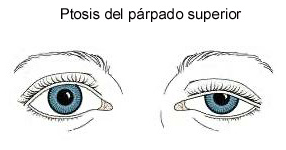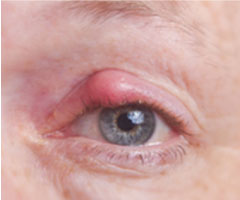Eyelids (functional)
It is the inability to adequately raise the upper eyelid. There are mild forms where the eyelid does not cover the pupil, and severe forms where the eye is fully covered. Causes range from blepharochalasis (excess of eyelid skin), a stretching of the tendon that joins the eyelid with the raising muscle, to muscle or neurological diseases.
Acquired ptosis can be corrected by way of an eyelid surgery intended to adjust the tendon, or a blepharoplasty where the purpose is aesthetic. There are several techniques to perform it and, in most cases, it leaves no scars. It is an outpatient surgery using local anesthesia and has a short postoperative period.


Entropion
Entropion is when the eyelid is improperly turned inward to the eye. This causes the eyelashes to brush against the cornea and the sensation of having a foreign body, with the potential risk of generating extremely painful ulcers and infections.
The most common type of entropion is involutional, generated by a laxity of the eyelid tendons. It is usually very uncomfortable for the patient and is treated through surgery. The surgery uses local anesthesia and the success rate is greater than 95%; the normal function of the eyelid is restored.

Ectropion
Ectropion, like entropion, is a pathology of the eyelid margin. The most common cause is involutional (due to aging) and consists of a hyper elasticity of the eyelid tissues. Among other causes is facial paralysis. In ectropion, the eyelid is turned outward and ceases to be in contact with the eye globe, so the eye cannot close properly. In the long term it may have serious consequences due to exposure, whether irritation, keratitis and chronic ulcers.
In this case a surgery is conducted to restore the normal eyelid position by using the lateral tarsal strip technique, stretching and securing the eyelid in its lateral angle. The procedure uses local anesthesia and lasts approximately 30 minutes.

A chalazion is a benign and very frequent eyelid injury. It develops after an improperly treated or untreated sty. It is a cyst-type injury that may be located either on the upper or lower eyelid, and can be very uncomfortable.
Chalazion surgery is conducted in the operating room using local anesthesia. It is a simple, easy and fast procedure and has no postoperative period.



They can be benign (such as papilloma and cysts) or malignant (skin carcinomas). They usually develop in the eyelid margin and may or may not affect the eyelashes. If malignity is suspected, a biopsy should be made to define the proper treatment. They usually require ulterior eyelid restoration.
It is the excess of skin over the eyelids. They do not affect the height of the eyelid, but may reduce the superior visual field when the excess is severe and touches the eyelashes. It is called pseudoptosis.
A non-frequent disorder that paralyzes the face muscles (most frequently hemifacial). It must be treated along with neurology and in case of functional aftereffects such as lagophthalmos (inability to close the eyelid completely) or ptosis, reconstructive surgery can be performed.
A pathological spasm of the muscles surrounding the eye. Patients who suffer from it report significant impairment in life quality. Botulinum toxin is injected to ease the spasm.